Search
- Page Path
- HOME > Search
- [Korean]
- Evaluation of Oxygen Reduction and Surface Chemical State of Ti-48Al-2Cr-2Nb Powder by Ca Vapor
- Taeheon Kim, Hanjung Kwon, Jae-Won Lim
- J Korean Powder Metall Inst. 2021;28(1):31-37. Published online February 1, 2021
- DOI: https://doi.org/10.4150/KPMI.2021.28.1.31

- 868 View
- 3 Download
- 2 Citations
-
 Abstract
Abstract
 PDF
PDF This study explores reducing the oxygen content of a commercial Ti-48Al-2Cr-2Nb powder to less than 400 ppm by deoxidation in the solid state (DOSS) using Ca vapor, and investigates the effect of Ca vapor on the surface chemical state. As the deoxidation temperature increases, the oxygen concentration of the Ti-48Al-2Cr-2Nb powder decreases, achieving a low value of 745 ppm at 1100°C. When the deoxidation time is increased to 2 h, the oxygen concentration decreases to 320pp m at 1100°C, and the oxygen reduction rate is approximately 78% compared to that of the raw material. The deoxidized Ti-48Al-2Cr-2nb powder maintains a spherical shape, but the surface shape changes slightly owing to the reaction of Ca and Al. The oxidation state of Ti and Al on the surface of the Ti-48Al-2Cr-2Nb powder corresponds to a mixture of TiO2 and Al2O3. As a result, the peaks of metallic Ti and Ti suboxide intensify as TiO2 and Al2O3 in the surface oxide layer are reduced by Ca vapor deposition
-
Citations
Citations to this article as recorded by- Production of spherical TiAl alloy powder by copper-assisted spheroidization
Jin Qian, Bo Yin, Dashun Dong, Geng Wei, Ming Shi, Shaolong Tang
Journal of Materials Research and Technology.2023; 25: 1860. CrossRef - Ca-Mg Multiple Deoxidation of Ti-50Al-2Cr-2Nb Intermetallic Compound Powder for Additive Manufacturing
Seongjae Cho, Taeheon Kim, Jae-Won Lim
ECS Journal of Solid State Science and Technology.2022; 11(4): 045008. CrossRef
- Production of spherical TiAl alloy powder by copper-assisted spheroidization
- [Korean]
- Mechanical Properties and Thermal Stability of Ti0.5Al0.5N/CrN Nano-multilayered Coatings
- Seung-Su Ahn, Jong-Keuk Park, Kyung-Sik Oh, Tai-Joo Chung
- J Korean Powder Metall Inst. 2020;27(5):406-413. Published online October 1, 2020
- DOI: https://doi.org/10.4150/KPMI.2020.27.5.406

- 408 View
- 2 Download
-
 Abstract
Abstract
 PDF
PDF Ti0.5Al0.5N/CrN nano-multilayers, which are known to exhibit excellent wear resistances, were prepared using the unbalanced magnetron sputter for various periods of 2–7 nm. Ti0.5Al0.5N and CrN comprised a cubic structure in a single layer with different lattice parameters; however, Ti0.5Al0.5N/CrN exhibited a cubic structure with the same lattice parameters that formed the superlattice in the nano-multilayers. The Ti0.5Al0.5/CrN multilayer with a period of 5.0 nm exceeded the hardness of the Ti0.5Al0.5N/CrN single layer, attaining a value of 36 GPa. According to the low-angle X-ray diffraction, the Ti0.5Al0.5N/CrN multilayer maintained its as-coated structure up to 700°C and exhibited a hardness of 32 GPa. The thickness of the oxidation layer of the Ti0.5Al0.5N/CrN multilayered coating was less than 25% of that of the single layers. Thus, the Ti0.5Al0.5N/CrN multilayered coating was superior in terms of hardness and oxidation resistance as compared to its constituent single layers.
- [Korean]
- Effect of Surfactant on the Dispersion Stability of Slurry for Semiconductor Silicon CMP
- Hye Won Yun, Doyeon Kim, Do Hyung Han, Dong Wan Kim, Woo-Byoung Kim
- J Korean Powder Metall Inst. 2018;25(5):395-401. Published online October 1, 2018
- DOI: https://doi.org/10.4150/KPMI.2018.25.5.395
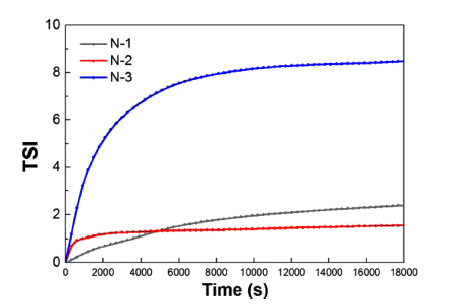
- 1,798 View
- 40 Download
- 1 Citations
-
 Abstract
Abstract
 PDF
PDF The improvement of dispersion stability for the primary polishing slurry in a CMP process is achieved to prevent defects produced by agglomeration of the slurry. The dispersion properties are analyzed according to the physical characteristics of each silica sol sample. Further, the difference in the dispersion stability is confirmed as the surfactant content. The dispersibility results measured by Zeta potential suggest that the dispersion properties depend on the content and size of the abrasive in the primary polishing slurry. Moreover, the optimum ratio for high dispersion stability is confirmed as the addition content of the surfactant. Based on the aforementioned results, the long-term stability of each slurry is analyzed. Turbiscan analysis demonstrates that the agglomeration occurs depending on the increasing amount of surfactant. As a result, we demonstrate that the increased particle size and the decreased content of silica improve the dispersion stability and long-term stability.
-
Citations
Citations to this article as recorded by- Surface Defect Properties of Prime, Test-Grade Silicon Wafers
Seung-Hwan Oh, Hyeonmin Yim, Donghee Lee, Dong Hyeok Seo, Won Jin Kim, Ryun Na Kim, Woo-Byoung Kim
Korean Journal of Materials Research.2022; 32(9): 396. CrossRef
- Surface Defect Properties of Prime, Test-Grade Silicon Wafers
- [Korean]
- Effect of Mn Addition on Sintering Properties of Ti-10wt.%Al-xMn Powder Alloy
- Gi-Seung Shin, Yong-Taek Hyun, Nho-Kwang Park, Yong-Ho Park, Dong-Geun Lee
- J Korean Powder Metall Inst. 2016;24(3):235-241. Published online June 1, 2016
- DOI: https://doi.org/10.4150/KPMI.2017.24.3.235
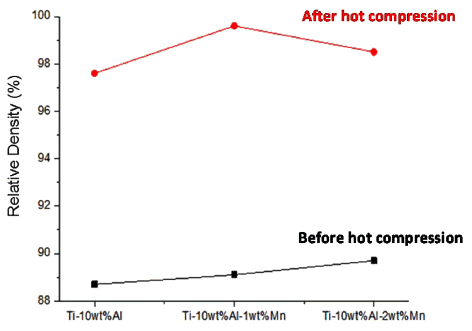
- 664 View
- 2 Download
- 2 Citations
-
 Abstract
Abstract
 PDF
PDF Titanium alloys have high specific strength, excellent corrosion and wear resistance, as well as high heatresistant strength compared to conventional steel materials. As intermetallic compounds based on Ti, TiAl alloys are becoming increasingly popular in the aerospace field because these alloys have low density and high creep properties. In spite of those advantages, the low ductility at room temperature and difficult machining performance of TiAl and Ti3Al materials has limited their potential applications. Titanium powder can be used in such cases for weight and cost reduction. Herein, pre-forms of Ti-Al-xMn powder alloys are fabricated by compression forming. In this process, Ti powder is added to Al and Mn powders and compressed, and the resulting mixture is subjected to various sintering temperature and holding times. The density of the powder-sintered specimens is measured and evaluated by correlation with phase formation, Mn addition, Kirkendall void, etc. Strong Al-Mn reactions can restrain Kirkendall void formation in Ti-Al-xMn powder alloys and result in increased density of the powder alloys. The effect of Al-Mn reactions and microstructural changes as well as Mn addition on the high-temperature compression properties are also analyzed for the Ti-Al-xMn powder alloys.
-
Citations
Citations to this article as recorded by- Lattice Deformation and Improvement Oxidation Resistance of Ti-6Al-4V Alloy Powders Prepared by Hydrogen Added Argon Heat Treatment
Gye-Hoon Cho, Jung-Min Oh, Jae-Won Lim
Journal of Korean Powder Metallurgy Institute.2019; 26(2): 126. CrossRef - Effect of post heat treatment on fatigue properties of EBM 3D-printed Ti-6Al-4V alloy
Young-Sin Choi, Ji-Hoon Jang, Gun-Hee Kim, Chang-Woo Lee, Hwi-Jun Kim, Dong-Geun Lee
Journal of Korean Powder Metallurgy Institute.2018; 25(4): 340. CrossRef
- Lattice Deformation and Improvement Oxidation Resistance of Ti-6Al-4V Alloy Powders Prepared by Hydrogen Added Argon Heat Treatment
- [English]
- A Study on Synthesis of Ni-Ti-B Alloy by Mechanical Alloying from Elemental Component Powder
- Jung Geun Kim, Yong Ho Park
- J Korean Powder Metall Inst. 2016;23(3):202-206. Published online June 1, 2016
- DOI: https://doi.org/10.4150/KPMI.2016.23.3.202

- 1,083 View
- 3 Download
- 2 Citations
-
 Abstract
Abstract
 PDF
PDF A Ni-Ti-B alloy powder prepared by mechanical alloying (MA) of individual Ni, Ti, and B components is examined with the aim of elucidating the phase transitions and crystallization during heat treatment. Ti and B atoms penetrating into the Ni lattice result in a Ni (Ti, B) solid solution and an amorphous phase. Differential thermal analysis (DTA) reveals peaks related to the decomposition of the metastable Ni (Ti, B) solid solution and the separation of equilibrium Ni3Ti, TiB2, and τ-Ni20Ti3B6 phases. The exothermal effects in the DTA curves move to lower temperatures with increasing milling time. The formation of a TiB2 phase by annealing indicates that the mechanochemical reaction of the Ni-Ti-B alloy does not comply with the alloy composition in the ternary phase diagram, and Ti-B bonds are found to be more preferable than Ni-B bonds.
-
Citations
Citations to this article as recorded by- Solid‐State Synthesis and Characterization of the Stable Nanostructured Ni21Ti2B6 Phase
Tuncay Simsek, Baris Avar, Sadan Ozcan, Arun K. Chattopadhyay, Bora Kalkan
physica status solidi (b).2021;[Epub] CrossRef - Synthesis and analysis of nanocrystalline β1-Cu3Al and β2-NiAl intermetallic-reinforced aluminum matrix composite by high energy ball milling
Hong-Hai Nguyen, Minh-Thuyet Nguyen, Won Joo Kim, Jin-Chun Kim
Metals and Materials International.2017; 23(1): 202. CrossRef
- Solid‐State Synthesis and Characterization of the Stable Nanostructured Ni21Ti2B6 Phase
- [Korean]
- Dispersion Control and Characterization of the SiO2/PMMA Particles Using Surface Charge
- Yubin Kang, Soojung Son, Kun-Jae Lee
- J Korean Powder Metall Inst. 2015;22(6):403-407. Published online December 1, 2015
- DOI: https://doi.org/10.4150/KPMI.2015.22.6.403
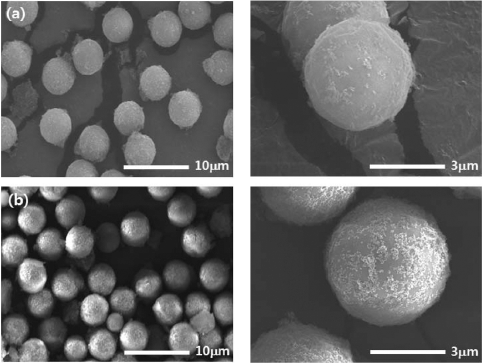
- 784 View
- 6 Download
- 2 Citations
-
 Abstract
Abstract
 PDF
PDF Poly-methylmetacrylate (PMMA) is mainly applied in the plastic manufacturing industry, but PMMA is weak and gradually got discolor. The strength of PMMA can be improved through organic-inorganic hybrid nano composites with inorganic nano particles such as, SiO2 or ZrO. However, inorganic nano particles are mostly agglomerated spontaneously. In this study, the zeta potential is controlled using different types of organic solvent with different concentrations, dispersibillity of SiO2 nano particles on the PMMA particle are analyzed. When 3 M acetic acid is used, absolute value of the zeta potential is higher, SiO2 nano particle is well attached, and dispersed on the PMMA particle surface. Results indicate that the absolute value of the zeta potential affects the stability of SiO2 dispersion.
-
Citations
Citations to this article as recorded by- A Study of Organic Impurity Removal Efficiency for Waste LCD Touch Panel Glass by Solvents Types
Yubin Kang, Jin-Ju Choi, Jae Layng Park, Chan Gi Lee
Journal of the Korean Institute of Resources Recycling.2020; 29(6): 57. CrossRef - Hard Surface-adhesive Properties of TiO2 Nanoparticles-encapsulated Microparticles Prepared by Spray Drying and Surface Coating Method
Su-Kyung Kim, Jong-Duk Kim, Seung-Jun Lee
Fibers and Polymers.2018; 19(6): 1303. CrossRef
- A Study of Organic Impurity Removal Efficiency for Waste LCD Touch Panel Glass by Solvents Types
- [Korean]
- Evaluation of Material Characteristics with Sintering Temperature in Ti2AlC MAX Phase Material using Spark Plasma Sintering Method
- Chang-Hun Lee, Gyung Rae Baek, Hee Sang Jung, Young-Keun Jeong, Myung Chang Kang
- J Korean Powder Metall Inst. 2015;22(3):175-180. Published online June 1, 2015
- DOI: https://doi.org/10.4150/KPMI.2015.22.3.175

- 856 View
- 7 Download
- 1 Citations
-
 Abstract
Abstract
 PDF
PDF In this study, ternary compound Max Phase Ti2AlC material was mixed by 3D ball milling as a function of ball milling time. More than 99.5 wt% pure Ti2AlC was synthesized by using spark plasma sintering method at 1000, 1100, 1200, and 1300°C for 60 min. The material characteristics of synthesized samples were examined with relative density, hardness, and electrical conductivity as a function of sintering temperature. The phase composition of bulk was identified by X-ray diffraction. On the basis of FE-SEM result, a terraced structures which consists of several laminated layers were observed. And Ti2AlC bulk material obtained a vickers hardness of 5.1 GPa at the sintering temperature of 1100°C.
-
Citations
Citations to this article as recorded by- Synthesis and reaction path of Ti‐Al‐C MAX phases by reaction with Ti‐Al intermetallic compounds and TiC
Hojun Lee, Si Yeon Kim, Young‐In Lee, Jongmin Byun
Journal of the American Ceramic Society.2023; 106(12): 7230. CrossRef
- Synthesis and reaction path of Ti‐Al‐C MAX phases by reaction with Ti‐Al intermetallic compounds and TiC
- [Korean]
- Characteristics of Material Properties and Machining Surface in Electrical Discharge Machining of Ti2AlN and Ti2AlC Materials
- Eui-Song Choi, Chang-Hoon Lee, Gyung-Rae Baek, KwangHo Kim, Myung Chang Kang
- J Korean Powder Metall Inst. 2015;22(3):163-168. Published online June 1, 2015
- DOI: https://doi.org/10.4150/KPMI.2015.22.3.163
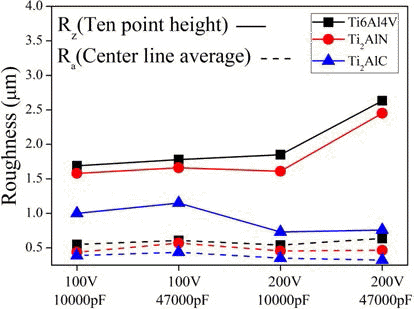
- 753 View
- 1 Download
- 1 Citations
-
 Abstract
Abstract
 PDF
PDF Ti alloys are extensively used in high-technology application because of their strength, oxidation resistance at high temperature. However, Ti alloys tend to be classified very difficult to cut material. In this paper, The powder synthesis, spark plasma sintering (SPS), bulk material properties such as electrical conductivity and thermal conductivity are systematically examined on Ti2AlN and Ti2AlC materials having most light-weight and oxidation resistance among the MAX phases. The bulk samples mainly consisted of Ti2AlN and Ti2AlC materials with density close to theoretical value were synthesized by a SPS method. Machining characteristics such as machining time, surface quality are analyzed with measurement of voltage and current waveform according to machining condition of micro-electrical discharge machining with micro-channel shape.
-
Citations
Citations to this article as recorded by- Comparative Study on Ablation Characteristics of Ti-6Al-4V Alloy and Ti2AlN Bulks Irradiated by Femto-second Laser
Ki Ha Hwang, Hua Feng Wu, Won Suk Choi, Sung Hak Cho, Myungchang Kang
Journal of the Korean Society of Manufacturing Process Engineers.2019; 18(7): 90. CrossRef
- Comparative Study on Ablation Characteristics of Ti-6Al-4V Alloy and Ti2AlN Bulks Irradiated by Femto-second Laser
- [Korean]
- Micro-EDM Feasibility and Material Properties of Hybrid Ti2AlC Ceramic Bulk Materials
- Guk-Hyun Jeong, Kwang-Ho Kim, Myung-Chang Kang
- J Korean Powder Metall Inst. 2014;21(4):301-306. Published online August 1, 2014
- DOI: https://doi.org/10.4150/KPMI.2014.21.4.301
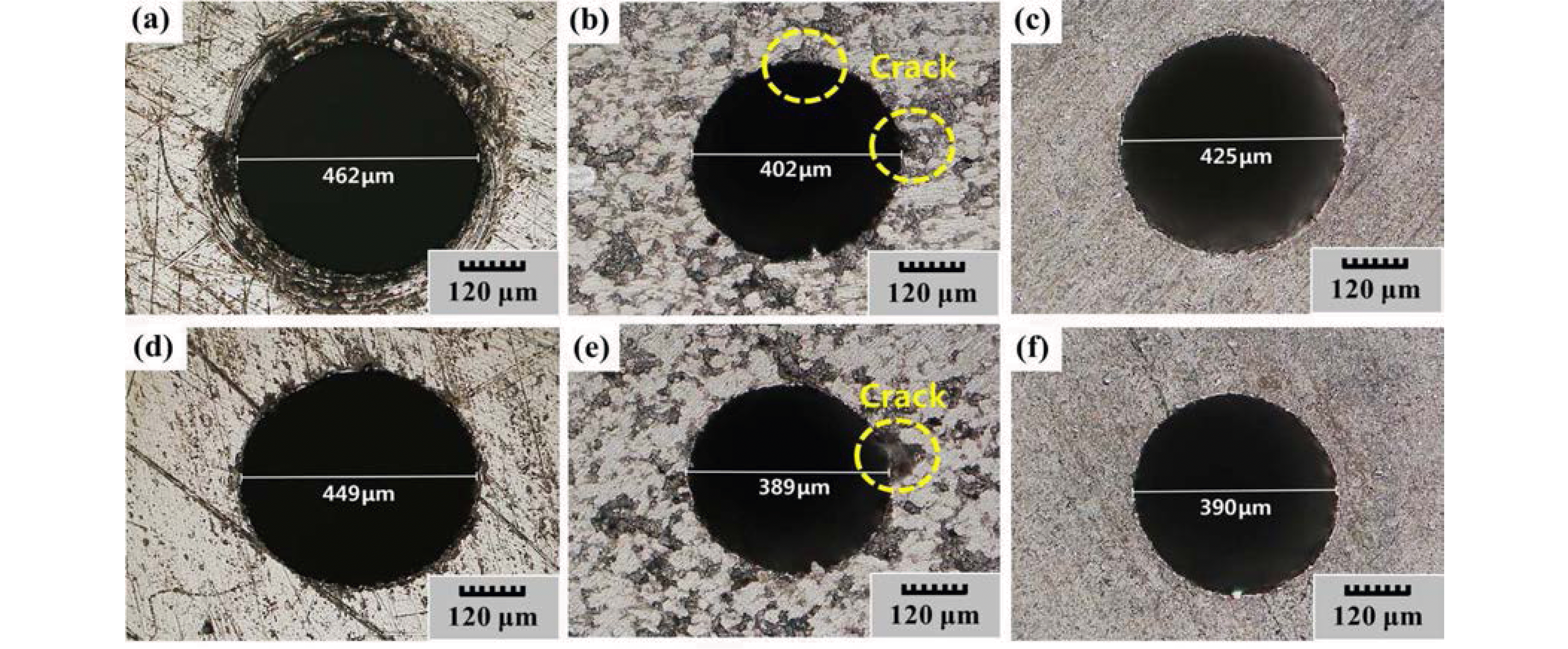
- 494 View
- 0 Download
- 1 Citations
-
 Abstract
Abstract
 PDF
PDF Titanium alloys are extensively used in high-temperature applications due to their excellent high strength and corrosion resistance properties. However, titanium alloys are problematic because they tend to be extremely difficult-tocut material. In this paper, the powder synthesis, spark plasma sintering (SPS), bulk material characteristics and machinability test of hybrid Ti2AlC ceramic bulk materials were systematically examined. The bulk samples mainly consisted of Ti2AlC materials with density close to theoretical value were synthesized by a SPS method. Random orientation and good crystallization of the Ti2AlC was observed at 1100°C for 10 min under SPS sintering conditions. Scanning electron microscopy results indicated a homogeneous distribution and nano-laminated structure of Ti2AlC MAX phase. The hardness and electrical conductivity of Ti2AlC were higher than that of Ti 6242 alloy at sintering temperature of 1000°C~1100°C. Consequently, the machinability of the hybrid Ti2AlC bulk materials is better than that of the Ti 6242 alloy for micro-EDM process of micro-hole shape workpiece.
-
Citations
Citations to this article as recorded by- Evaluation of Material Characteristics with Sintering Temperature in Ti2AlC MAX Phase Material using Spark Plasma Sintering Method
Chang-Hun Lee, Gyung Rae Baek, Hee Sang Jung, Young-Keun Jeong, Myung Chang Kang
Journal of Korean Powder Metallurgy Institute.2015; 22(3): 175. CrossRef
- Evaluation of Material Characteristics with Sintering Temperature in Ti2AlC MAX Phase Material using Spark Plasma Sintering Method
- [English]
- Coating of Cobalt Over Tungsten Carbide Powder by Wet Chemical Reduction Method
- Hyun-Seon Hong, Jin-Ho Yoon
- J Korean Powder Metall Inst. 2014;21(2):93-96. Published online April 1, 2014
- DOI: https://doi.org/10.4150/KPMI.2014.21.2.93
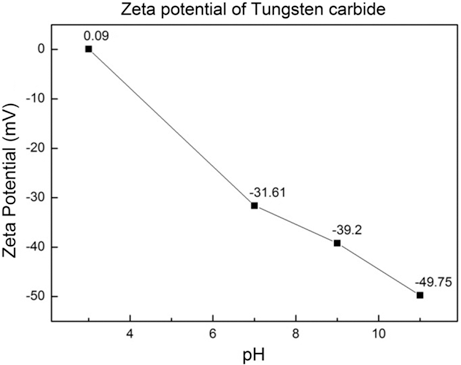
- 1,186 View
- 6 Download
- 3 Citations
-
 Abstract
Abstract
 PDF
PDF Cobalt coated tungsten carbide-cobalt composite powder has been prepared through wet chemical reduction method. The cobalt sulfate solution was converted to the cobalt chloride then the cobalt hydroxide. The tungsten carbide powders were added in to the cobalt hydroxide, the cobalt hydroxide was reduced and coated over tungsten carbide powder using hypo-phosphorous acid. Both the cobalt and the tungsten carbide phase peaks were evident in the tungsten carbide-cobalt composite powder by X-ray diffraction. The average particle size measured via scanning electron microscope, particle size analysis was around 380 nm and the thickness of coated cobalt was determined to be 30~40 nm by transmission electron microscopy.
-
Citations
Citations to this article as recorded by- Electroless Ni-P deposition on WC powders through direct PdCl2 activation and study on the underlying mechanisms
Peng Tang, Shuwen Jiang, Jiawei Yan, Xianquan Li
Next Materials.2025; 6: 100496. CrossRef - Pre-treatments of initial materials for controlling synthesized TaC characteristics in the SHS process
Jae Jin Sim, Sang Hoon Choi, Ji Hwan Park, Il Kyu Park, Jae Hong Lim, Kyoung Tae Park
journal of Korean Powder Metallurgy Institute.2018; 25(3): 251. CrossRef - Spark plasma sintering of WC–Co tool materials prepared with emphasis on WC core–Co shell structure development
Sungkyu Lee, Hyun Seon Hong, Hyo-Seob Kim, Soon-Jik Hong, Jin-Ho Yoon
International Journal of Refractory Metals and Hard Materials.2015; 53: 41. CrossRef
- Electroless Ni-P deposition on WC powders through direct PdCl2 activation and study on the underlying mechanisms
TOP
 KPMI
KPMI


 First
First Prev
Prev


